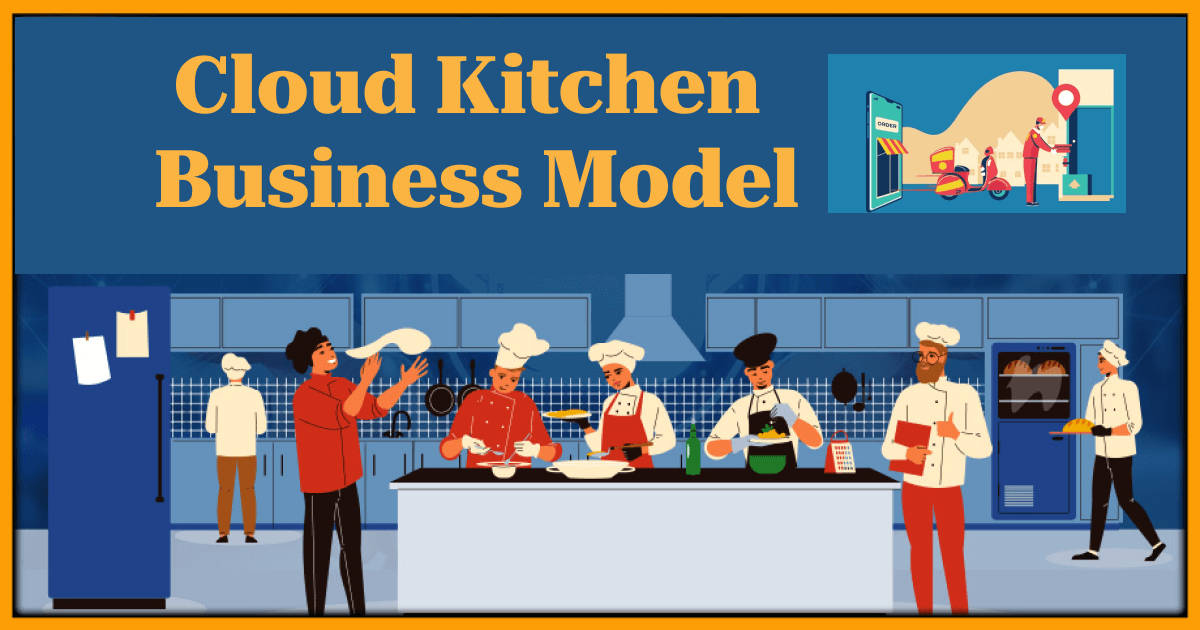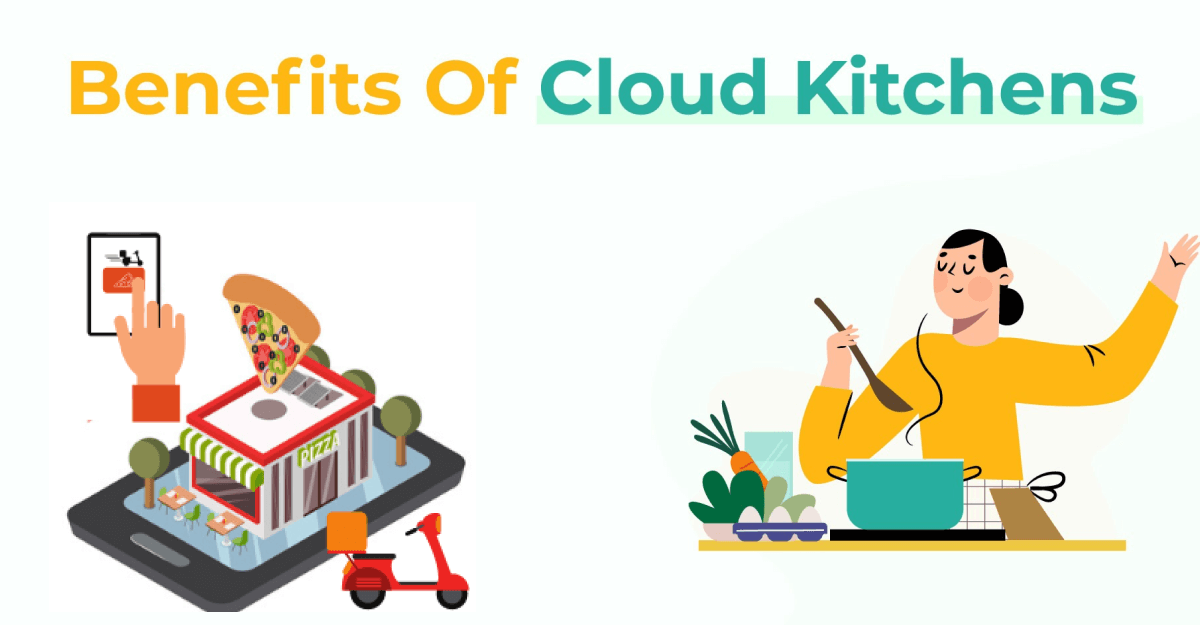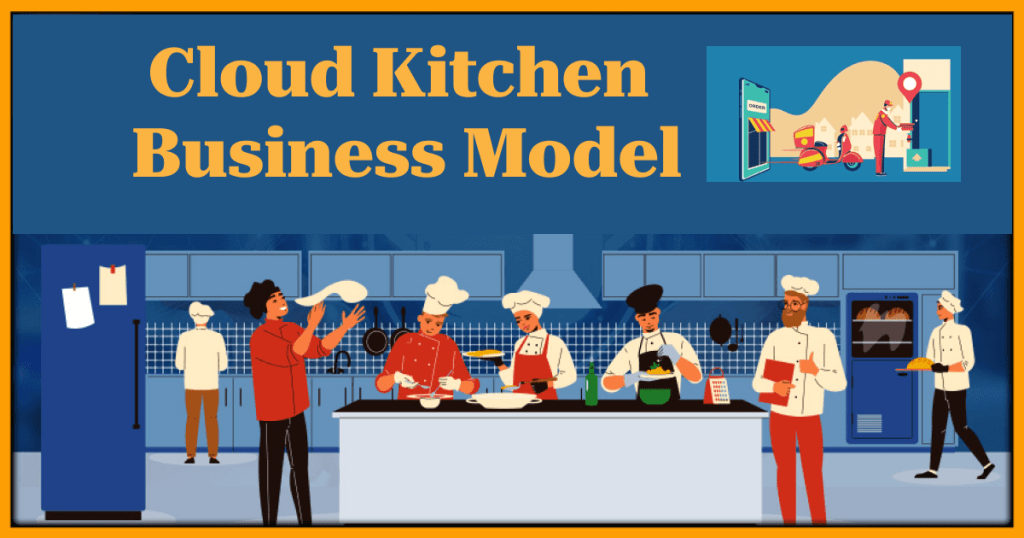With the popularity of the food delivery segment, a common term that pops out is “Cloud Kitchen” or only kitchen-as-a-service! Don’t you wonder how it became wildly successful despite being a rookie startup idea? The primary reason is its delivery-only business model. Not only is it cost-effective but also streamlined multiple revenue sources. In this article, we will decode the “Cloud Kitchen Business Model” and you will get thorough information about it.

Let’s begin!
What Is A Cloud Kitchen?
A cloud kitchen is a commercial kitchen devoid of dine-in customers. You can order food from the cloud kitchen but cannot eat there because the dining facilities are absent. This kind of kitchen facility is designed for the preparation of meals for online orders. Then, the cooked food is delivered to your doorstep through its app or other food delivery apps like Swiggy, Zomato, UberEAts, DoorDash, etc.
This sort of food-service establishment that operates exclusively for delivery or takeout is known by different names.
- Virtual Kitchen
- Ghost Kitchen
- Dark Kitchen
- Shadow Kitchen
- Commissary Kitchen
Examples
Currently, there are over 3500 cloud kitchens in India. It is expected that this industry will be worth over $2 billion in India by 2024.

- Faasos by Revel Foods
- Behrouz Biryani
- Oven Story
- Sweet Truth
- Firangi Bake
- Mandarin Oak
- The Good Bowl
- Lunch Box
- Navarasam
- Hoi Foods
- Biryani By Kilo
The Concept of Cloud Kitchens
Cloud kitchens typically operate in a centralized location, often in urban areas with high population density. You may observe a high number of cloud kitchens in metro cities like New Delhi, Bengaluru, Mumbai, etc. It may house multiple restaurant brands or concepts within the same kitchen space. These kitchen facilities are equipped with commercial-grade cooking equipment, storage, and preparation areas, and are used by multiple food businesses to prepare their menu items. Each food brand within the cloud kitchen operates as a separate entity, often with its branding, online ordering system, and delivery service, while sharing the same kitchen infrastructure and resources.

Benefits/Advantages of cloud kitchens over traditional restaurants
Cloud kitchens offer several advantages over traditional restaurants. Some of the essential ones are-
1. Lower Overhead Costs: Cloud kitchens typically have lower startup costs and ongoing overhead costs compared to traditional restaurants. If you open a Cloud Kitchen, you won’t have to invest in dining space, interior decor, and front-of-house staff, which can significantly reduce operating expenses, such as rent, utilities, and labor. You can simply focus on the quality and quantity of food.
2. Increased Flexibility and Scalability: Cloud kitchens allow for greater flexibility and scalability in food operations. You can quickly launch new concepts or test new menu items without the need for a physical restaurant space. This flexibility enables faster response to changing customer demands and market trends and allows for easy expansion or contraction of operations based on business performance. Also, you can easily swap your menu if any ingredient becomes unavailable or expensive.
Beneficial for operations
- Enhanced Focus on Online Operations: Cloud kitchens are designed exclusively for online orders so that you can solely focus on delivery or takeout operations. This allows for streamlined processes and optimized workflows for online orders, which can result in more efficient operations and faster order fulfillment. It provides a better opportunity for experimentation. You can easily scrape down new ideas to experiment with new concepts.
- Access to Prime Locations: Cloud kitchens are often located in urban areas with high population densities. This feature provides access to prime locations without the high costs associated with traditional restaurant locations. This can provide cloud kitchens with better visibility, proximity to target customers, and potential for increased order volume.
- Reduced Dependency on Dining-In Traffic: Cloud kitchens are not dependent on dine-in traffic, which can be unpredictable and subject to seasonality or external factors. This can provide more stability to food businesses, especially during challenging times, such as during the COVID-19 pandemic when dine-in traffic was significantly impacted, Cloud Kitchens observed a significant boom in its popularity.
- Affordable Investment Business: You need less labor and infrastructure to establish a cloud kitchen. You can begin Cloud Kitchen with less capital too! Therefore, it is considered a lean business with a low-risk venture as compared to a traditional brick-and-mortar restaurant.
Some other key benefits-
- Lower Risk and Faster ROI: Due to lower startup costs and overhead expenses, cloud kitchens can offer a lower-risk option for food entrepreneurs to enter the market. With potentially faster return on investment (ROI) and shorter payback periods, cloud kitchens can be an attractive option for those looking to start or expand their food business.
- Data-Driven Operations: This is the most crucial factor with which Cloud Kitchen beats traditional restaurants. Cloud kitchens often leverage technology and data-driven operations, which can provide insights into customer preferences, order patterns, and operational efficiencies. This data can be used to optimize menus, pricing, and operations, leading to data-informed decision-making and improved business performance. Also, fewer people are required to execute the business of cloud kitchens.
Thus, cloud kitchens offer several advantages over traditional restaurants. Since its operations are confined only to the maintenance of the kitchen and the quality of food, it is easy to expand its operations to test new markets and the perception of customers.
The Rise of food delivery apps and their role in the Cloud Kitchen Business Model

Undoubtedly, food delivery apps have revolutionized the restaurant industry of our nation. It changed the way we order and consume food. This change occurred during the covid-19 lockdowns and post-pandemic period. Some crucial roles of food delivery apps in the Cloud Kitchen Business Model are-
Intermediary
Cloud kitchens operate without any dine-in or storefront facilities. Instead, they rely solely on online orders through food delivery apps for their business and to attract customers. Food delivery apps act as intermediaries between cloud kitchens and consumers, providing a platform for customers to order food online and have it delivered to their doorstep.
Convenience
Another driver of the cloud kitchen model’s rise is the increasing demand for convenience among consumers. Food delivery apps provide a convenient and hassle-free way for people to order food from a variety of restaurants or cloud kitchens without leaving their homes. This has led to a significant shift in consumer behavior, with more people opting for food delivery as a preferred dining option.
Cost-effective solution to grab a large customer base
Food delivery apps provide a cost-effective solution for cloud kitchens to reach a wider customer base without investing in expensive dine-in facilities or marketing efforts. By leveraging the customer base of food delivery apps, cloud kitchens can expand their reach and increase their sales potential. It is advantageous for customers too! They get food at a lesser price as compared to dine-in restaurants.
Valuable data and insights
Food delivery apps provide valuable data and insights to cloud kitchens. These apps generate vast amounts of data on consumer preferences, ordering habits, and feedback, which cloud kitchens can use to optimize their menus, pricing, and operations. This data-driven approach allows cloud kitchens to adapt and cater to changing consumer demands, leading to improved customer satisfaction and loyalty.
Building brands and a loyal customer base
Food delivery apps offer a platform for cloud kitchens to build their brand and establish a loyal customer base. Cloud kitchens can leverage the marketing and promotional features of food delivery apps to create awareness, engage with customers, and build a strong online presence. This allows cloud kitchens to establish their brand identity and differentiate themselves in a competitive market.
Key Components of Cloud Kitchen Business Model

The key components of a cloud kitchen business model typically include:
Online Ordering Platform
As we have explained above, cloud kitchen relies heavily on an online ordering platform or food delivery app. It provides numerous features such as menu customization, payment processing, online ordering, and order tracking.
Centralized Commercial Kitchens
The kitchen infrastructure is a crucial component of a cloud kitchen business model. In a centralized commercial cloud kitchen, multiple restaurant brands operate out of a single shared kitchen facility. Here, the kitchen infrastructure and resources are owned and managed by a central entity, which leases kitchen space and equipment to multiple restaurant brands. It typically includes-
- Well-established Kitchen Infrastructure & Food Preparation: The kitchen is designed to be efficient and optimized for food delivery, with a focus on maximizing production output and minimizing costs. It includes the physical kitchen space, cooking equipment, and storage facilities.
- Technology and Operations: Technology plays a significant role in the operations of a cloud kitchen. This includes order management systems, kitchen management software, inventory management tools, and other technologies to streamline operations, manage orders, track deliveries, and monitor performance.
Delivery Process
- Delivery and Logistics: This includes managing delivery drivers or partnering with third-party delivery services, optimizing delivery routes, and ensuring timely and reliable deliveries for multiple restaurant brands operating from the central kitchen. For this purpose, they usually undergo partnerships with food delivery apps.
- Supply Chain Management: An efficient supply chain is critical to the success of a cloud kitchen business model. This includes sourcing high-quality ingredients at competitive prices, managing inventory levels, and establishing relationships with reliable suppliers. Effective supply chain management helps in minimizing food costs, reducing wastage, and ensuring timely deliveries while gaining profits.
Marketing and Branding Strategies

The marketing strategies of cloud kitchens are unique as compared to the commercials of traditional restaurants. These are highly focused on reaching potential customers online. Here are some key marketing strategies that cloud kitchens can employ-
- Online Presence: Having a strong online presence is crucial for cloud kitchens because they fully operate on the internet. This includes a professional website, active social media profiles, and online listings on popular food delivery platforms. They create websites and social media profiles and incorporate visually appealing food photos and videos. All the information about the menu, pricing, and ordering processes are clear and crisp.
- Digital Marketing: Cloud kitchens can leverage digital marketing techniques such as search engine optimization (SEO), pay-per-click (PPC) advertising, and social media marketing to increase their online visibility and reach. These advertisements allow for targeted advertising on platforms like Google Ads or social media platforms to drive traffic to the website or online ordering platform.
- Branding: Building a strong brand image is essential for cloud kitchens. This includes creating a distinctive brand name, logo, and visual identity that reflects the cuisine, style, and personality of the cloud kitchen.
- Partnerships: Collaborating with other local businesses or food delivery apps is also an important marketing strategy for cloud kitchens. This includes joint promotions, cross-promotions, or co-branded campaigns to reach new audiences and expand the customer base.
Revenue Streams for Cloud Kitchens

Revenue streams for cloud kitchens can vary depending on the services they offer. Here, are some common revenue streams for cloud kitchens:
Food sales
The primary revenue stream for cloud kitchens is the sale of food. Cloud kitchens prepare and sell a wide variety of cuisines, ranging from fast food to traditional Indian food. Customers can place orders through online platforms or apps, and the cloud kitchen prepares and delivers the food or makes it available for pickup.
Delivery fees
This is applicable as a revenue stream only if the cloud kitchen delivers the food to the customer on its own. That is without the help of any other food delivery app. Cloud kitchens often charge delivery fees to customers for the convenience of having food delivered to their doorstep. These fees can vary depending on the distance, location, and platform used for delivery, and can contribute to the overall revenue of the cloud kitchen.
(Note: If the cloud kitchens deliver the food by partnering with other food delivery apps, then they need to pay a commission for it. In that case, delivery fees cannot be counted as revenue).
Catering Services
Cloud kitchens can create catering packages that include a selection of menu items specifically designed for catering purposes. These packages can be priced at a premium to account for the additional services and customization involved in catering, such as delivery, setup, and presentation. Catering packages generate additional revenue for the cloud kitchen.
Bulk orders
Cloud kitchens can offer discounts or special pricing for bulk orders, encouraging customers to place larger orders for events, offices, or other group settings. Bulk orders typically involve higher quantities of food. It can generate higher revenue margins for the cloud kitchen, even with discounted pricing of the food.
White labeling
It involves providing food products or services to other businesses that can be rebranded and sold under their brand name. Cloud kitchens can partner with food service businesses, such as restaurants, cafes, hotels, or retailers. Thus, it provides well-prepared food products to them and they can sell under their brand. The cloud kitchen charges a fee or a markup on the cost of goods sold (COGS) to generate revenue from white labeling.
Franchising
Franchising involves granting the rights to use a cloud kitchen’s brand, operational processes, and business model to other entrepreneurs or businesses in exchange for a franchise fee or ongoing royalties. Franchisees pay upfront fees and ongoing royalties to the cloud kitchen in exchange for using their brand and operational system, which generates revenue for the cloud kitchen.
Challenges and Considerations for Cloud Kitchen Businesses

High Competition in the Market
Cloud kitchen industry is becoming increasingly saturated, with more players entering the market. High competition can lead to price wars, reduced profit margins, and difficulty in differentiating your brand from others.
Staying ahead of the competition and constantly innovating is crucial in this dynamic market. But the cloud kitchen can get ace the competition by developing the following ways-
- Unique value proposition
- Conducting thorough market research
- Investing in branding and marketing
- Focusing on customer experience
- Implementing a competitive pricing strategy
- Innovating your menu
- Ensuring operational efficiency
Ensuring Food Quality & Safety
Ensuring food quality and safety is a top priority for any cloud kitchen business, as it directly impacts customer satisfaction, brand reputation, and compliance with food safety regulations. Here are some key steps to ensure food quality and safety in a cloud kitchen:
- Executing robust food safety practices
- Providing regular training to staff
- Maintaining proper documentation
- Adhering to food safety regulations.
Maintaining Delivery Speed & Efficiency
Delivery is a critical component of cloud kitchen business, and managing logistics can be a challenge. Coordinating deliveries across multiple virtual restaurant brands, optimizing delivery routes, and managing last-mile delivery can be complex and require efficient logistics management.
The following measures can help you to identify areas for improvement and continually enhance your delivery operations.
- Implementing efficient order management
- Providing proper training to delivery drivers
- Maintaining compliance with regulations
- Regular monitoring, audits, and customer feedback.
Final Words: The Future of Cloud Kitchens Business Model

The future of cloud kitchens is expected to be bright and promising as the demand for online food delivery continues to grow. Here are some potential trends and developments that could shape the future of cloud kitchens-
Technological advancements and their impact on the cloud kitchen business model
Technology will likely play a significant role in the future of the cloud kitchen business model. Innovations such as robotic automation, artificial intelligence (AI), and data analytics could enhance operational efficiency, reduce costs, and improve the customer experience.
For example, robotic chefs and automated order fulfillment systems could streamline the cooking and packing processes, while AI-powered algorithms could optimize menu offerings and pricing based on customer preferences and demand.
Note: At present, North America, Canada, Japan, and Singapore are leading the markets for A.I.-powered kitchens and robotic chefs.
Expansion Opportunities and Potential Growth
It can arise in various ways, depending on the specific business model, market conditions, and strategic goals. Expansion into suburban and rural areas is an untapped opportunity for cloud kitchens. Currently, they are more prevalent in urban areas where population density and demand for online food delivery are high.
However, in the future, we may see cloud kitchens expanding into suburban and rural areas to cater to underserved markets.
The Role of Sustainability and Eco-friendly Practices
To maintain sustainable and eco-friendly practices is essential to minimize harsh environmental impact and promote sustainability. This could include using sustainable packaging materials, implementing energy-efficient technologies, and reducing food waste through data-driven inventory management and demand forecasting.
Ultimately, this measure will enhance the brand reputation of Cloud Kitchen.


Amazing Article :)) The Industry has also welcomed innovative technologies with AI for cost reduction of prepared/delivered food and improving standards of services.
Cloud Kitchen will be the first preference of the consumer as they prefer to order online rather than visit a restaurant, especially on weekends. The reason for this inclination is comfort eating because of the convenience and mobility of consumers. I see the cloud kitchen market is going to expand at a higher rate in the future with the surge in the demand for online food delivery services.